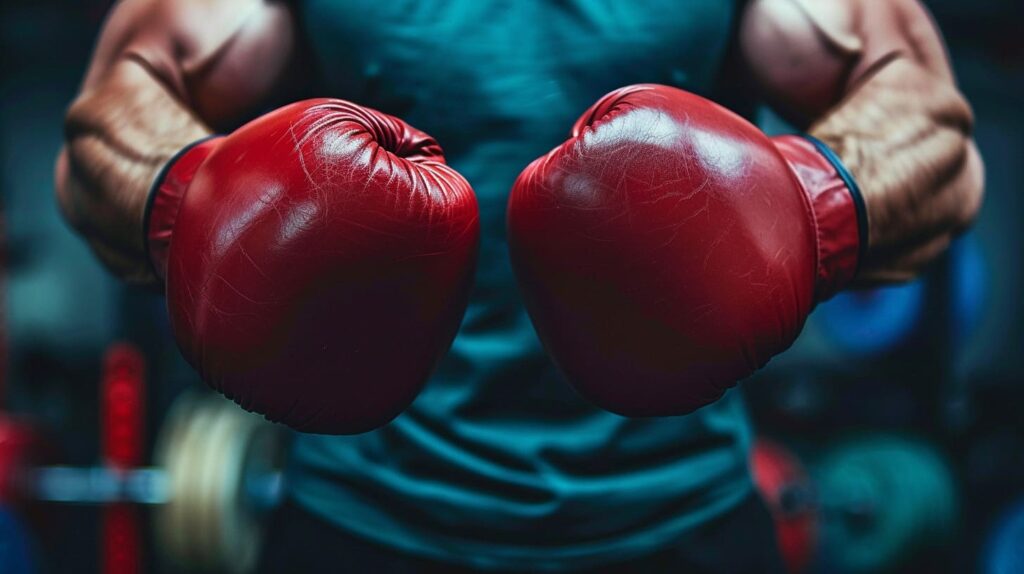Boxers lean heavily on weight training to ramp up their punch power and ring agility. It’s all about building muscle and boosting the force behind each hit. Key moves? Think squats, deadlifts, and bench presses—these aren’t just about getting stronger, they’re about making every move in the ring count. Kettlebell workouts, with their explosive lifts, are another secret weapon for fighters. They target the muscles that matter most in boxing, ensuring fighters are quick, powerful, and ready to outlast their opponents.
The Importance of Strength Training in Boxing

Strength training plays a crucial role in boxing, helping boxers develop power, speed, and endurance.
By incorporating strength training into their routines, boxers can build muscle mass, increase bone density, and boost overall physical performance. One essential aspect is resistance training, which involves using weights, resistance bands, or bodyweight exercises to target specific muscle groups. An example of a strength training routine for boxers might include exercises like squats, deadlifts, push-ups, pull-ups, and core strengthening exercises.
These routines aid in improving punching power, footwork agility, and stamina during fights. They help in preventing common boxing injuries by strengthening muscles around vulnerable areas such as the shoulders, wrists, and core.
What Muscles Do Boxers Use?
Boxers utilize a wide range of muscles in their upper body, lower body, and core to deliver powerful punches and maintain agility in the ring.
For instance, the trapezius, deltoids, and triceps in the upper body are crucial for generating punching force, while the lower body muscles such as the quadriceps, hamstrings, and calves provide stability and power in footwork. A strong core, including the abdominal muscles and obliques, is essential for maintaining balance and transferring energy efficiently during punches and defensive movements. Muscles like the latissimus dorsi and rotator cuff also play significant roles in shoulder stabilization and generating rotational power for hooks and uppercuts.
How Does Weight Lifting Affect a Boxer’s Performance?

Weight lifting can significantly impact a boxer’s performance by increasing their power and explosiveness in the ring.
By incorporating weight training into their regimen, boxers can enhance their punching power through targeted exercises that strengthen the muscles involved in throwing punches. Weight lifting helps improve overall strength, enabling boxers to maintain their stance, absorb blows, and deliver more forceful counterattacks with greater stability.
Contrary to popular belief, weight lifting does not make boxers slow or bulky. When done correctly under proper guidance, it can actually increase speed by improving muscle coordination and enhancing the efficiency of movement patterns.
Does Weight Lifting Make You Slower?
Contrary to the myth, weight lifting does not necessarily make boxers slower; when done correctly, weight training can actually enhance a boxer’s speed and agility.
Weight training can help boxers improve their explosiveness by enhancing their muscle power and strength. By targeting specific muscle groups used in boxing movements, such as the legs, core, and shoulders, boxers can generate more force and speed in their punches and footwork.
Incorporating exercises that focus on quick movements and reaction time, such as plyometrics and agility drills, can further sharpen a boxer’s reflexes and overall speed inside the ring.
Does Weight Lifting Make You Bulky?
Weight lifting alone does not automatically make boxers bulky; specific training methods can focus on strength without excessive muscle mass gain.
Contrary to popular belief, boxers do not strive to pack on muscle mass like bodybuilders. In fact, incorporating weight lifting into their training regimen is essential for developing functional strength and power. By utilizing compound exercises such as squats, deadlifts, and bench presses, boxers can enhance their overall performance without adding unnecessary bulk. High-intensity interval training and plyometric exercises are crucial for improving agility, speed, and explosive power without compromising flexibility.
Does Weight Lifting Improve Punching Power?
Weight lifting is known to enhance a boxer’s punching power by strengthening the muscles involved in generating force for impactful strikes.
When a boxer engages in weight lifting, they specifically target muscles such as the biceps, triceps, shoulders, and core, which are essential for delivering powerful punches. By increasing muscle mass and strength through weight training, a boxer not only improves their ability to generate force but also enhances their overall stamina and endurance during bouts. Incorporating explosive exercises like power cleans and plyometrics into their workout routine helps in developing fast-twitch muscle fibers, enabling the boxer to deliver swifter and more potent punches. This combination of muscle strength and explosive power is crucial for maximizing punching effectiveness and overall performance in the ring.
Does Weight Lifting Help with Endurance?
Weight lifting can contribute to a boxer’s endurance by building overall strength and stamina needed to sustain performance during prolonged fights.
When a boxer engages in weight lifting exercises, they target specific muscle groups crucial for generating power and explosiveness in their punches. This increased strength not only enhances their ability to land impactful blows but also aids in withstanding the physical demands of a match. Strength training promotes better muscular endurance, allowing the boxer to maintain a high level of performance throughout the fight without succumbing to fatigue.
By incorporating weightlifting into their training regimen, boxers can reduce the risk of muscle fatigue and improve their overall stamina. Building a solid foundation of strength through weight training helps boxers endure prolonged bouts, enhancing their chances of outlasting opponents and securing victory in the ring.
The Right Way to Incorporate Weight Lifting into Boxing Training

Incorporating weight lifting effectively into a boxer’s training routine requires a balanced approach that targets specific muscle groups and performance goals.
It is essential for boxers to focus on a well-rounded strength program that not only enhances their power and explosiveness but also addresses their agility, endurance, and overall physical conditioning.
Compound lifts such as deadlifts, squats, and bench presses play a crucial role in building functional strength and muscle coordination, which are invaluable for boxing performance.
Integrating functional exercises like medicine ball slams, resistance band rotations, and sled pushes can further improve a boxer’s core stability, balance, and proprioception, essential for delivering powerful punches and maintaining defensive techniques.
What Types of Weight Exercises Should Boxers Do?
Boxers should focus on performing compound lifts, such as squats, deadlifts, and bench presses, to target multiple muscle groups and enhance functional strength.
Exercises like overhead presses and pull-ups are highly beneficial for boxers, as they engage the upper body, core, and stabilizer muscles, improving overall power and stability.
The clean and jerk is another excellent compound movement that challenges coordination, explosiveness, and full-body strength, all crucial aspects for boxing performance.
Incorporating these diverse exercises into a boxer’s training regimen helps build strength, endurance, and resilience for the demands of the sport.
How Often Should Boxers Lift Weights?

Boxers should consider weight lifting sessions 2-4 times per week to allow for adequate recovery and muscle growth while maintaining performance gains.
It is crucial for boxers to find the right balance in their weight lifting frequency to optimize their training without compromising their performance. By spreading these sessions throughout the week, they can ensure consistent progress while avoiding burnout and overtraining. The intensity of the weight lifting workouts should also be adjusted according to individual strength levels and training goals.
Incorporating rest days in between sessions is essential to allow the muscles to recover and adapt to the stress placed on them during training. This recovery time is when the real muscle growth occurs, leading to overall strength gains over time.
Should Boxers Focus on High Reps or Heavy Weights?
Boxers can benefit from a combination of both high-rep and heavy-weight training to develop muscular endurance and strength.
High-repetition training helps boxers enhance their muscular endurance by targeting slow-twitch muscle fibers, which are essential for prolonged bouts of activity in the ring. On the other hand, heavy-weight training aids in building raw strength and explosive power by engaging fast-twitch muscle fibers, crucial for quick and powerful movements during boxing exchanges. By incorporating both training methods, boxers can strike a balance between endurance and strength, allowing them to withstand longer fights while delivering impactful punches. This holistic approach to training contributes to overall physical performance improvement in the sport of boxing.
How to Avoid Overtraining and Injury When Lifting Weights for Boxing
To prevent overtraining and injury while weight lifting for boxing, boxers should focus on proper form, adequate rest, and gradual progression in training intensity.
Proper warm-up routines play a crucial role in preparing the muscles and joints for the demands of weight lifting. Boxers should incorporate dynamic stretches and light cardiovascular exercises to increase blood flow and flexibility.
Recovery strategies such as adequate hydration, nutrition, and sleep are vital for optimal muscle repair and growth. Taking rest days to allow the body to recover is just as important as the training itself.
Listening to the body’s signals is key; if experiencing persistent pain or fatigue, it’s essential to modify the training intensity or seek professional advice to prevent serious injuries.
The Benefits of Weight Lifting for Boxers

Weight lifting offers numerous benefits for boxers, including enhanced muscle growth, strength, power, and overall performance in the ring.
One of the key advantages of weight lifting for boxers is its ability to enhance muscle development. By engaging in targeted weight training, boxers can effectively build lean muscle mass, which not only increases their strength but also improves their endurance and explosive power.
Functional strength is another critical aspect that weight lifting contributes to a boxer’s training regime. Contrary to common misconceptions, weight training can help boxers develop functional strength that translates directly into their performance inside the ring, enabling faster punches, better footwork, and increased resilience.
Weight lifting plays a crucial role in enhancing overall athletic performance for boxers. It helps in improving speed, agility, and coordination, elements that are vital for success in the sport. By incorporating weight lifting into their training routine, boxers can better prepare themselves for the physical demands of boxing matches.
Frequently Asked Questions
Do boxers lift weights?
Yes, boxers do incorporate weightlifting into their training regimen. However, the type and intensity of weightlifting varies among different boxers and is dependent on their training goals and weight class.
Why do boxers lift weights?
Weightlifting helps boxers build strength and power in their punches, as well as improve their overall physical fitness. It also helps with injury prevention and can increase muscle endurance, which is crucial for the long rounds in a boxing match.
Are there any risks for boxers who lift weights?
Like any type of physical training, there are risks involved in weightlifting for boxers. Overdoing it or using improper form can lead to injuries. That’s why it’s important for boxers to have a qualified trainer or coach to guide them in their weightlifting routine.
Do all boxers lift the same amount of weights?
No, the amount of weight a boxer lifts depends on their training goals and weight class. Heavyweight boxers may lift heavier weights to build power, while lighter weight classes may focus more on lighter weights and higher repetitions for muscle endurance.
When do boxers usually incorporate weightlifting into their training?
Weightlifting is usually included in the strength and conditioning phase of a boxer’s training, which can vary depending on their training schedule and upcoming fights. Some may do it year-round, while others may focus on it more during the off-season.
Can weightlifting make a boxer slower or bulkier?
If done correctly, weightlifting should not make a boxer slower or bulkier. In fact, it can improve their speed, power, and agility. However, if a boxer overdoes it or does not maintain proper form, it can negatively impact their performance in the ring.

